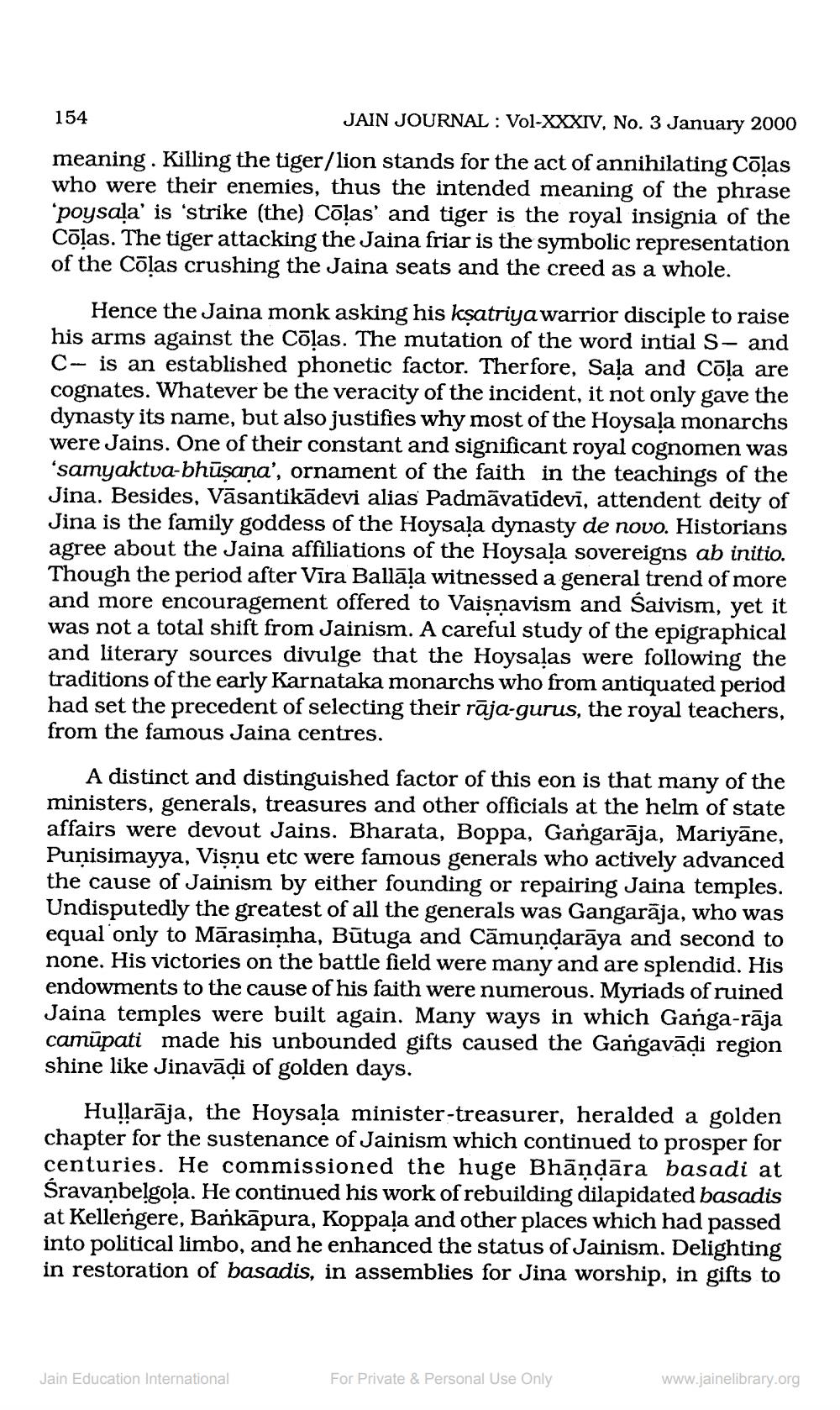________________
JAIN JOURNAL: Vol-XXXIV, No. 3 January 2000 meaning. Killing the tiger/lion stands for the act of annihilating Cōlas who were their enemies, thus the intended meaning of the phrase 'poysala' is 'strike (the) Cōlas' and tiger is the royal insignia of the Cōlas. The tiger attacking the Jaina friar is the symbolic representation of the Cōlas crushing the Jaina seats and the creed as a whole.
154
Hence the Jaina monk asking his kṣatriya warrior disciple to raise his arms against the Cōlas. The mutation of the word intial S- and C- is an established phonetic factor. Therfore, Sala and Cōla are cognates. Whatever be the veracity of the incident, it not only gave the dynasty its name, but also justifies why most of the Hoysala monarchs were Jains. One of their constant and significant royal cognomen was 'samyaktva-bhūṣaṇa', ornament of the faith in the teachings of the Jina. Besides, Väsantikādevi alias Padmavatidevi, attendent deity of Jina is the family goddess of the Hoysala dynasty de novo. Historians agree about the Jaina affiliations of the Hoysala sovereigns ab initio. Though the period after Vira Ballāļa witnessed a general trend of more and more encouragement offered to Vaiṣṇavism and Śaivism, yet it was not a total shift from Jainism. A careful study of the epigraphical and literary sources divulge that the Hoysalas were following the traditions of the early Karnataka monarchs who from antiquated period had set the precedent of selecting their raja-gurus, the royal teachers, from the famous Jaina centres.
A distinct and distinguished factor of this eon is that many of the ministers, generals, treasures and other officials at the helm of state affairs were devout Jains. Bharata, Boppa, Gangarāja, Mariyāne, Punisimayya, Visņu etc were famous generals who actively advanced the cause of Jainism by either founding or repairing Jaina temples. Undisputedly the greatest of all the generals was Gangarāja, who was equal only to Mārasimha, Būtuga and Camuṇḍarāya and second to none. His victories on the battle field were many and are splendid. His endowments to the cause of his faith were numerous. Myriads of ruined Jaina temples were built again. Many ways in which Ganga-rāja camupati made his unbounded gifts caused the Gangavādi region shine like Jinavāḍi of golden days.
Hullarāja, the Hoysala minister-treasurer, heralded a golden chapter for the sustenance of Jainism which continued to prosper for centuries. He commissioned the huge Bhāṇḍāra basadi at Śravanbelgola. He continued his work of rebuilding dilapidated basadis at Kellengere, Bankapura, Koppala and other places which had passed into political limbo, and he enhanced the status of Jainism. Delighting in restoration of basadis, in assemblies for Jina worship, in gifts to
Jain Education International
For Private & Personal Use Only
www.jainelibrary.org




